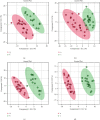Metabolite Comparison between Spleen-Deficiency and Healthy Children
- PMID: 37089718
- PMCID: PMC10115538
- DOI: 10.1155/2023/5937308
Metabolite Comparison between Spleen-Deficiency and Healthy Children
Abstract
Objective: From the perspective of metabolomics, this study compares the metabolomics characteristics of feces and urine between children with spleen-deficiency and healthy children to explain the scientific connotation of children with spleen-deficiency susceptibility to digestive system diseases from the metabolic level and provide a scientific basis for further research.
Methods: This study included 20 children with spleen-deficiencies and 17 healthy children. Children's symptom scores, height, and weight were recorded in groups, and feces and urine samples were collected. The samples were detected using ultrahigh-performance liquid chromatography-mass spectrometry. The data were analyzed using multivariate statistical analysis such as principal component analysis (PCA) and partial least squares discriminant analysis (PLS-DA). Related differential metabolites were identified through database comparisons between two groups based on the MS and KEGG.
Results: Compared to healthy children, the metabolites glucuronic acid, xanthine, and indole-3-acetaldehyde tend to be reduced in children with spleen-deficiency. Moreover, these children showed an increase in metabolites such as quinic acid, adenine, 4-methyl-5-thiazole-ethanol, 3-formyl indole, and 5-hydroxy indole-3-acetic acid. The condition affected many of the critical metabolic pathways, including the metabolism of tryptophan, cysteine, methionine, and pentose phosphate.
Conclusion: The children with spleen-deficiency had disorders at the metabolic level, which might be due to factors such as diet, personal preferences, and genes, leading to various symptoms, making spleen-deficiency children more prone to suffer from digestive diseases than healthy children. The results set a basis for the research on children's TCM constitution, which can be a reference to further studies to deal with the spleen-deficiency.
Copyright © 2023 Zhiyi Liang et al.
Conflict of interest statement
The authors declare that they have no conflicts of interest.
Figures








Similar articles
-
GC-MS and metabolomics analysis of amino acids, glucose and urinary metabolic pathways and characteristics in children with spleen-deficiency diarrhea.Cell Mol Biol (Noisy-le-grand). 2020 Jul 31;66(5):125-130. Cell Mol Biol (Noisy-le-grand). 2020. PMID: 33040825
-
[Identification of biomarkers in urine of rats with spleen Qi deficiency and biological significance].Zhongguo Zhong Yao Za Zhi. 2017 Dec;42(24):4855-4863. doi: 10.19540/j.cnki.cjcmm.20170919.003. Zhongguo Zhong Yao Za Zhi. 2017. PMID: 29493158 Chinese.
-
[Spleen deficiency and phlegm dampness syndrome model in rats treated by Citri Reticulatae Pericarpium based on metabolomics].Zhongguo Zhong Yao Za Zhi. 2022 Aug;47(15):4136-4147. doi: 10.19540/j.cnki.cjcmm.20220218.701. Zhongguo Zhong Yao Za Zhi. 2022. PMID: 36046904 Chinese.
-
[Analysis of differences between unifloral honeys from different botanical origins based on non-targeted metabolomics by ultra-high performance liquid chromatography-quadrupole time-of-flight mass spectrometry].Se Pu. 2021 Mar;39(3):291-300. doi: 10.3724/SP.J.1123.2020.06029. Se Pu. 2021. PMID: 34227310 Free PMC article. Chinese.
-
Study on plasmatic metabolomics of Uygur patients with essential hypertension based on nuclear magnetic resonance technique.Eur Rev Med Pharmacol Sci. 2014;18(23):3673-80. Eur Rev Med Pharmacol Sci. 2014. PMID: 25535139
Cited by
-
Lipidomics study of Liujunzi decoction in hyperlipidemia rats with spleen deficiency based on UPLC-Q-TOF/MS.Heliyon. 2024 May 22;10(11):e31710. doi: 10.1016/j.heliyon.2024.e31710. eCollection 2024 Jun 15. Heliyon. 2024. PMID: 38882295 Free PMC article.
References
-
- Liang X., Wang Q., Jiang Z., et al. Clinical research linking Traditional Chinese Medicine constitution types with diseases: a literature review of 1639 observational studies. Journal of Traditional Chinese Medicine . 2020;40(4):690–702. - PubMed
-
- Wang Q. Reconsideration of the three key scientific issues of TCM constitution and its prospect: speech at the 19th academic annual meeting of the TCM Constitution Branch, China Association of Chinese Medicine. Journal of Beijing University of Traditional Chinese Medicine . 2021;44(12):1061–1066.
LinkOut - more resources
Full Text Sources

